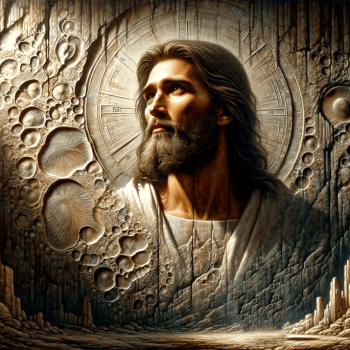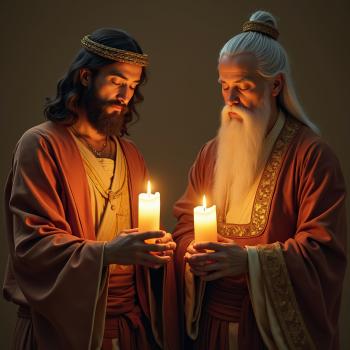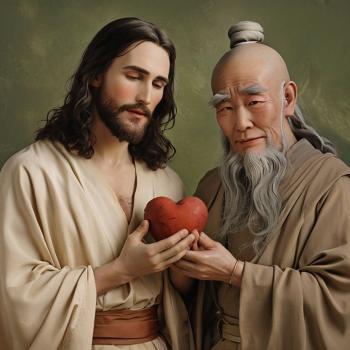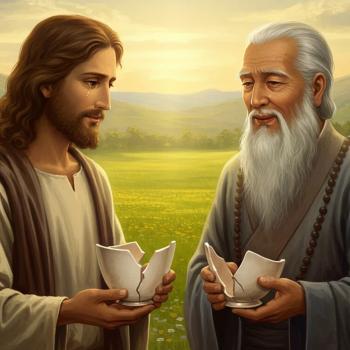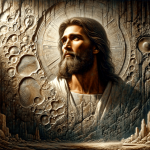It’s hard to trust in what you can’t see, hear, or grasp. Jesus and Lao Tzu demonstrate confidence in the divine mystery.
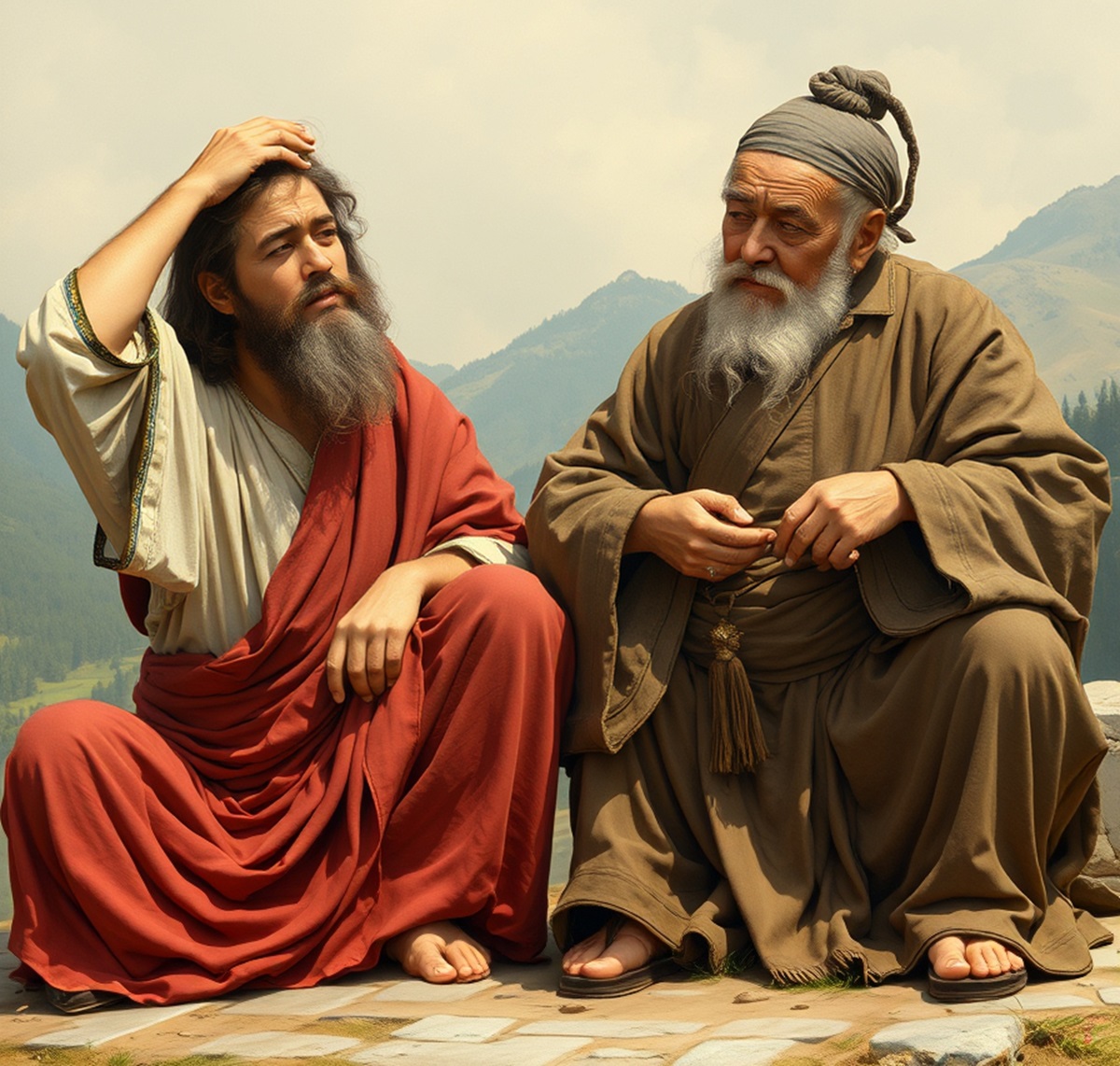
Jesus and Lao Tzu knew that people want to rely on sure things. They also knew that the divine mystery isn’t exactly a sure thing to most people. The author of the New Testament’s book of Hebrews says, “Now faith is the assurance of things hoped for, the conviction of things not seen.” How can you be certain when God is an enigma? In the fourteenth verse of the Tao Te Ching, Lao Tzu weighs in.
Lao Tzu’s Tao Te Ching, Verse 14
J.H. McDonald Translation
Look for it, and it can’t be seen.
Listen for it, and it can’t be heard.
Grasp for it, and it can’t be caught.
These three cannot be further described,
so we treat them as The One.Its highest is not bright.
Its depths are not dark.
Unending, unnameable, it returns to nothingness.
Formless forms, and imageless images,
subtle, beyond all understanding.Approach it and you will not see a beginning;
follow it and there will be no end.
When we grasp the Tao of the ancient ones,
we can use it to direct our life today.
To know the ancient origin of Tao:
this is the beginning of wisdom.
Holy Trinity of Unfathomable Oneness
Lao Tzu presents the reader with a holy Trinity of unfathomable oneness: “Look for it, and it can’t be seen. Listen for it, and it can’t be heard. Grasp for it, and it can’t be caught.” This reminds the Christian reader of the way Moses looked for God the father, but saw him only from the backside, and how the Israelites saw the numinous glory of God on the Mountain, though veiled in billows of smoke.
Similarly obscure, many New Testament witnesses heard the voice of the Holy Spirit, while others thought it had only thundered. We understand this elusive and ungraspable quality when Mary Magdalene clutches after the resurrected Jesus. In return, he says, “Do not touch me, because I have not yet ascended to the Father.” These are a few examples of Christian scripture’s evidence that God can neither be fully seen, heard, or grasped.
Opposites, in Constant Interplay
Of this holy trinity of unfathomable, God parallels the Tao. Lao Tzu writes, “These three cannot be further described, so we treat them as The One.” Many Christians disregard the mystery of the Tao. “You can’t affirm opposites like yin and yang at the same time,” then say. And yet, Christianity has its mysterious doctrine of Hypostatic Union, the idea that Jesus could be both fully human and fully divine. One might envision this mystery in the swirling dark and light in the Taoist symbol, in constant interplay.
Another mystery is that God is both eminent and transcendent. Again, one could depict this as yin and yang. To understand the mysteries of Taoism, Christians must see them in the light of similar Christian mysteries. The more you think you can understand the Tao, the less you can grasp it. “Its highest is not bright. Its depths are not dark.” Even yin contains a bit of yang, and the yang possesses an element of yin. The Holy Tao defies all explanations and challenges all categories.
The Absence of Name
Lao Tzu writes, “Unending, unnamable, it returns to nothingness. Formless forms, and imageless images, subtle beyond all understanding.” This is why, in the Ten Commandments, God said, “You shall have no other gods before me.” Remember that in the Hebrew scriptures, the name of God is not the Latinized Jehovah, but the Hebrew YHWH. “I am that I am” is simply a description of God as the essence of existence itself. Therefore, any god that can be encountered or worshiped is not truly God. Molech, Aphrodite, Quetzalcoatl, and Bast are all names of deities that people have constructed to try to get a handle on who God is. To put any of these gods ahead of God would be to worship the created thing instead of the creator. The only way to recognize the Creator is through and absence of a name.
The Tao that can be described is not the Tao. God is not even YHWH, but an Ultimate Reality beyond that name. For this reason, Moses forbade any graven images of God. Any attempt to depict God by painting, carving, or sculpting is bound to fall short. Why? “Look for it, and it can’t be seen. Listen for it, and it can’t be heard. Grasp for it, and it can’t be caught.” Of the Holy Trinity of the Unfathomable, Lao Tzu writes, “These three cannot be further described, so we treat the three as The One.” Any attempt to encapsulate God in an image is like grasping after the wind. The Tao is simply the Tao. And even that word is a clumsy moniker.
Trusting the Tao
Lao Tzu writes, “Approach it and you will not see a beginning; follow it and there will be no end. When we grasp the Tao of the ancient ones, we can use it to direct our life today. To know the ancient origin of Tao: this is the beginning of wisdom.” Following the same line of thought, the book of Proverbs says, “Trust in the Lord with all your heart, and do not rely on your own insight. In all your ways acknowledge him, and he will make straight your paths.”
The best way to trust the divine mystery is to recognize that it is beyond our understanding. If we constantly try to grasp the ungraspable, it becomes difficult to trust. Yet, by allowing the Infinite Flow to carry us, we participate in a journey we never would have imagined.
Something to Practice…
If you want to practice confidence in the ungraspable God, try exercising humility. Recognize that there is more that you don’t know about the Eternal than there is that you do know. Go ahead and read theological journals, but don’t get married to their doctrines. Train for martial arts but recognize that there’s always more that you have to learn—and often your opponents are your greatest teachers. Learn to hold loosely to the things you think are true, understanding that your understanding is limited. Throughout your interactions today, try to practice humility with other people. Then, apply that same modesty to what you think you know about God.





